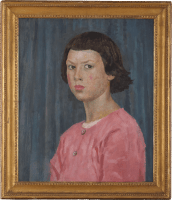Flamboyantly bohemian, Augustus John was one of the leading artist figures of the early twentieth century. Known primarily for his penetrating portraits of distinguished contemporaries, he pioneered the technique of oil sketching directly onto bare canvas.
Painted amid the First World War, this poignant portrait of the artist’s son captures the tensions of their turbulent relationship. The painting, which remained in John’s collection until his death, is an affecting example of John’s psychologically impactful portraiture.
Robin (1904-1988) was the third son of John and his wife Ida Nettleship (1877–1907). Nettleship died when Robin was only three years old, leaving him primarily under John’s care. The two had a difficult relationship. From a young age, Robin was well immersed within the epicentre of middle-class British bohemia and much of his early life included socializing with artists, writers and socialites such as Lady Ottoline Morell, which he seemingly came to resent. Robin's silences habitually infuriated his hot-headed father, who...
Flamboyantly bohemian, Augustus John was one of the leading artist figures of the early twentieth century. Known primarily for his penetrating portraits of distinguished contemporaries, he pioneered the technique of oil sketching directly onto bare canvas.
Painted amid the First World War, this poignant portrait of the artist’s son captures the tensions of their turbulent relationship. The painting, which remained in John’s collection until his death, is an affecting example of John’s psychologically impactful portraiture.
Robin (1904-1988) was the third son of John and his wife Ida Nettleship (1877–1907). Nettleship died when Robin was only three years old, leaving him primarily under John’s care. The two had a difficult relationship. From a young age, Robin was well immersed within the epicentre of middle-class British bohemia and much of his early life included socializing with artists, writers and socialites such as Lady Ottoline Morell, which he seemingly came to resent. Robin's silences habitually infuriated his hot-headed father, who declared his son ‘hardly utters a word and radiates hostility'. Of his father, Robin later recalled;
‘I’m sure he [Augustus John] regretted our inability – as I did – to achieve a friendly and easy relationship. But the main obstacle was that he – fundamentally – was a rebel against established society and most conventions, while I hated Bohemianism and yearned for a normal life – which made me in turn also a rebel – but in reverse’.[1]
The psychology of this reverse rebel is arguably apparent in the present portrait, notably due to the unyielding gaze through which Robin addresses his viewer. However, the informality of his relaxed pose, along with his flushed cheeks, long hair and pink lips indicates the familiarity of family. John often used his family as models, particularly for his less conventional works, as they provided an excellent means for artistic experimentation.
In this instance, John has primarily built his composition through colour-blocking; the blue background and pink shirt are executed in confident strokes of paint. The portrait is painted on a white primer, which also informs the colour of the layers on top – the result, in this case, is a beautifully harmonious combination of muted tones.
Other portraits of Robin by John are held within international collections such as the Tate, The Royal Academy, and The National Gallery of Victoria, Melbourne.
[1] R. John, to M. Holroyd, 13 Jan 1969, quoted in M. Holroyd, (1996) Augustus John: The New Biography. London: Chatto & Windus Limited, p. 539.













